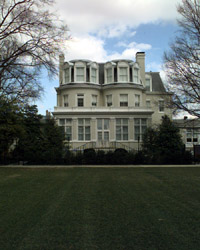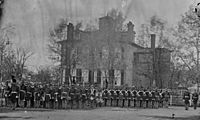Marine Barracks, Washington, D.C. facts for kids
Quick facts for kids Marine Barracks Washington |
|
|---|---|
| Washington, D.C. | |

Marine Barracks logo
|
|
| Type | Military base |
| Site information | |
| Controlled by | |
| Open to the public |
During parades and ceremonies |
| Site history | |
| Built | 1801 |
| In use | 1801 - present |
| Battles/wars | War of 1812 |
| Garrison information | |
| Current commander |
Colonel Teague A. Pastel |
| Past commanders |
Christian G. Cabaniss Charles Heywood James Carson Breckinridge Dennis Hejlik Benjamin T. Watson |
| Occupants | |
|
U.S. Marine Corps Barracks and Commandant's House
|
|
| Area | 6 acres (2.4 ha) |
| Architect | George Hadfield |
| NRHP reference No. | 72001435 |
| Significant dates | |
| Added to NRHP | December 27, 1972 |
| Designated NHLD | May 11, 1976 |
The Marine Barracks, Washington, D.C. is a very important place for the United States Marine Corps. It's located in Washington, D.C. at 8th and I Streets. This base was started way back in 1801, making it the oldest Marine Corps post still in use!
It's also a National Historic Landmark, which means it's a special place recognized for its history. The Barracks is where the Commandant of the Marine Corps (the top leader of the Marines) has lived since 1806. It's also the main place where the Marines hold their big ceremonies.
Two famous Marine groups call this place home: the United States Marine Drum and Bugle Corps (also known as "The Commandant's Own") and the United States Marine Band ("The President's Own"). Marines from the Barracks perform important ceremonial duties in Washington, D.C., and sometimes even in other countries. They also help with security in the city.
The Marine Barracks Washington and the historic home of the Commandants were officially listed as important historical sites in 1972. They became a National Historic Landmark in 1976.
Contents
History of the Marine Barracks
The buildings at the Marine Barracks are some of the oldest in Washington, D.C. In 1801, President Thomas Jefferson and Lieutenant Colonel William Ward Burrows, who was the leader of the Marine Corps, rode horses around the new capital city. They were looking for a good spot for the Marines.
They picked a place that was close enough to walk to both the Washington Navy Yard and the Capitol. They hired an architect named George Hadfield to design the barracks and the Commandant's House.
The War of 1812 and Bladensburg
During the War of 1812, British forces attacked and burned parts of Washington, D.C.. They also captured the Marine barracks. However, a special story is told in the Marine Corps. It's said that the British were so impressed by how bravely the Marines fought at the Battle of Bladensburg that they decided not to burn the barracks or the Commandant's House.
At the Battle of Bladensburg, about 100 Marines and 300 Navy sailors fought bravely. They used three large cannons to fire at the British soldiers. Their strong defense surprised the British. Even though the Americans eventually had to retreat, the Marines and sailors showed great courage.
This brave stand is still remembered today. Artist Charles Waterhouse painted a famous picture showing Captain Miller's Marines using the cannons. There's also a sculpture called "Undaunted in Battle" by Joanna Blake. It shows a wounded Captain Barney being helped by a Marine, with a sailor and a cannon nearby.
Becoming a National Historic Landmark
The area where the barracks stands was added to the National Register of Historic Places in 1972. Then, in 1976, it was named a National Historic Landmark by the Department of the Interior.
The Silent Drill Platoon and the Marine Band have been based at 8th and I Streets since the barracks opened in 1801. The Commandant's House became the official home of the Marine Corps leader in 1806. It's the only original building left at the complex, as most others were rebuilt around 1900 and 1907. The United States Marine Drum and Bugle Corps has been here since it started in 1934.
The Marine Barracks is one of the oldest government buildings in Washington, D.C., that has been used continuously. Some people debate if the White House is a year older. While the Barracks is known as the "oldest post in the Corps," Marines were actually at the Charlestown Navy Yard a year earlier. However, they didn't have a permanent base there until later.
Important Marine Units
The Marine Barracks is home to several special Marine units:
- Headquarters and Service Company
- Marine Corps Enlisted Aide Program
- Ceremonial Companies A & B
- The United States Marine Corps Color Guard - part of Company A
- Marine Corps Silent Drill Platoon - part of Company A
- Marine Corps Body Bearers - part of Company B
- Guard Company
- Marines serving the White House Communications Agency
- Security Company
- United States Marine Drum and Bugle Corps
- United States Marine Band
What Marines Do Here
Marines at the Barracks have many important jobs:
- They serve as funeral escorts for Marines and important people.
- They act as a ceremonial honor guard for special events with government leaders.
- They provide security for places like Camp David and the White House Communications Agency.
- They perform in impressive parades:
- The Friday Evening Parade at the Barracks.
- The Tuesday Sunset Parade at the Marine Corps War Memorial (also known as the Iwo Jima Memorial).
- They also train regularly to keep their skills sharp and be ready for emergencies.
Marines chosen to serve at the D.C. barracks must meet strict rules for height, weight, and background checks. This is because they perform in parades, funerals, and other ceremonies for the President and other important national leaders.
During the summer, a sunset parade happens every Tuesday evening at the Marine Corps War Memorial in Rosslyn, Virginia, which is near Arlington National Cemetery. Also, an evening parade takes place at the Barracks every Friday evening from late spring until the end of summer. Since 2018, you can sometimes watch the sunset parade from the Barracks live on Facebook!




